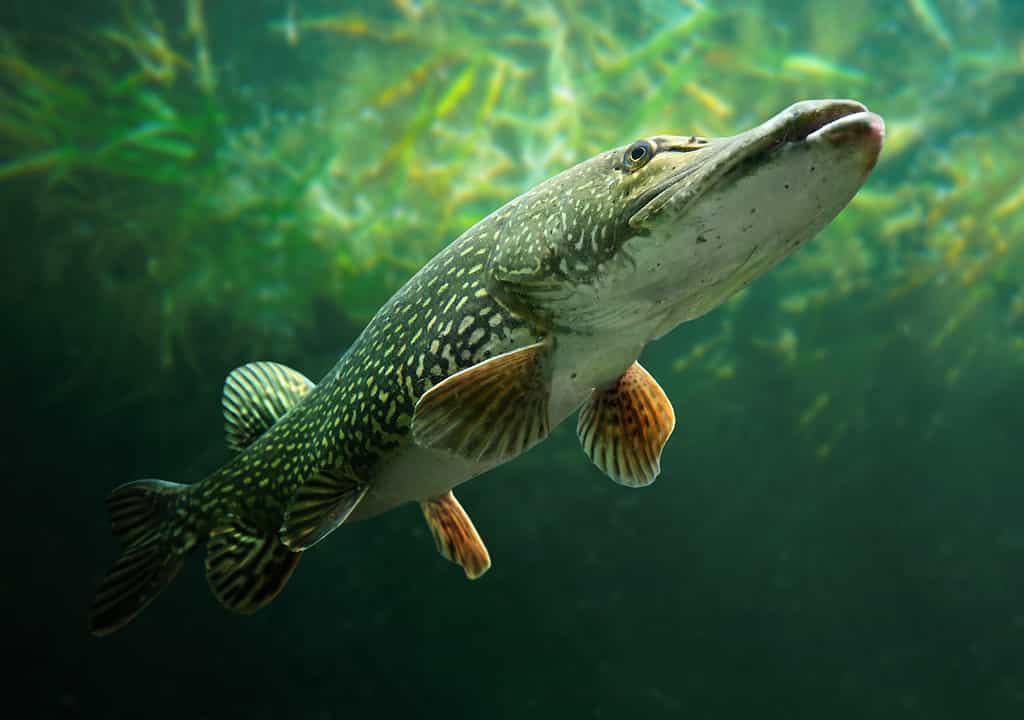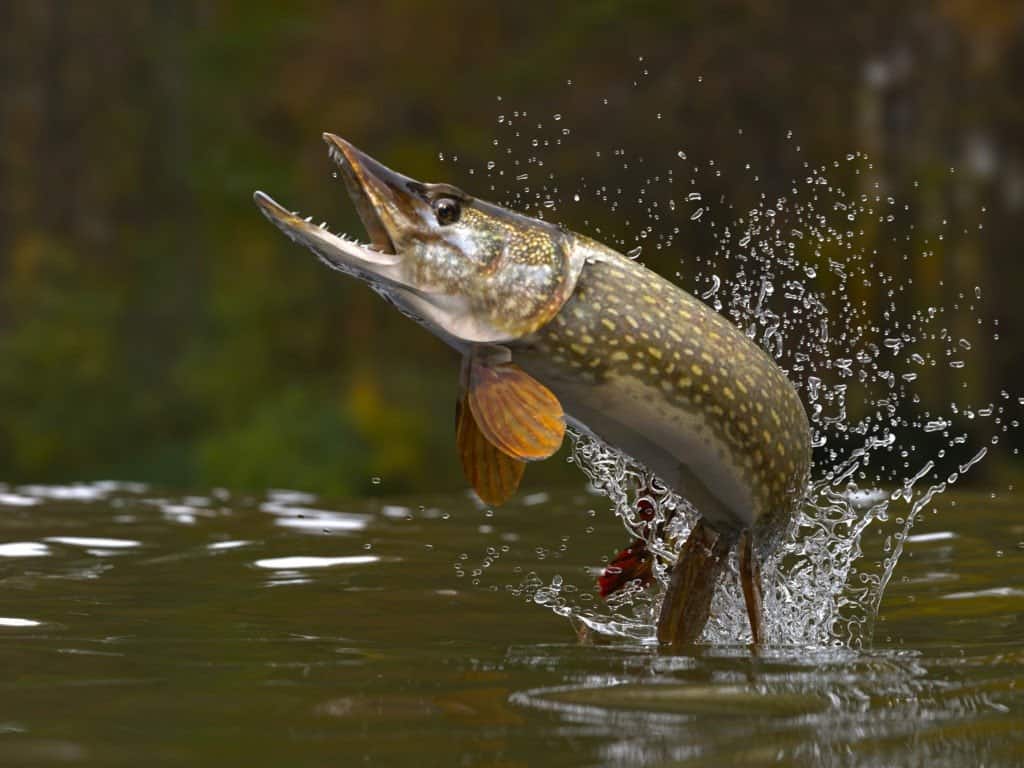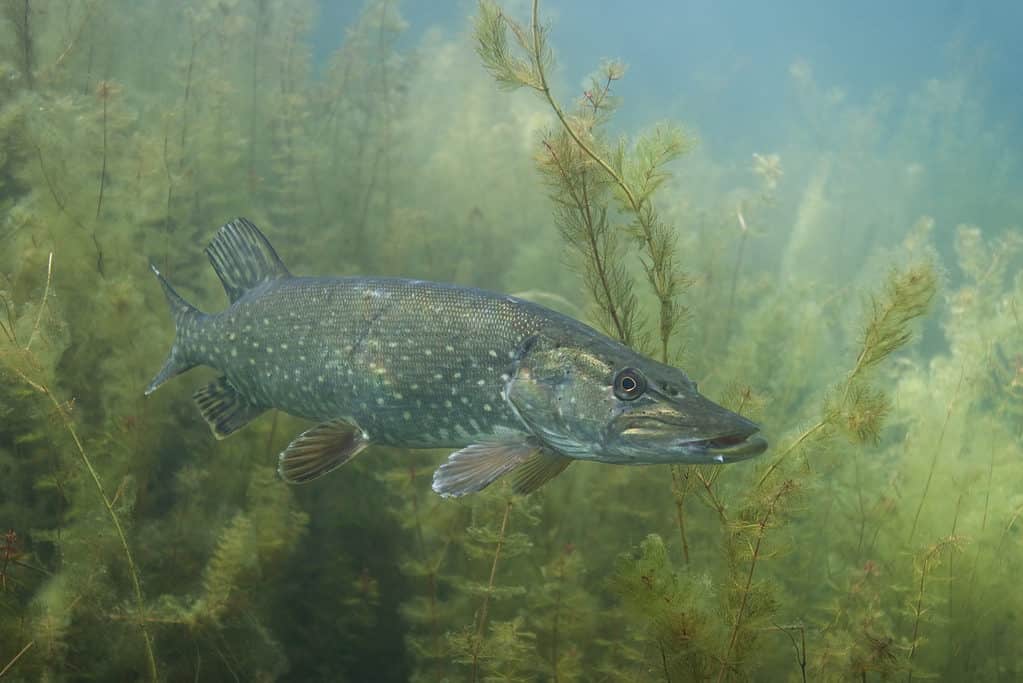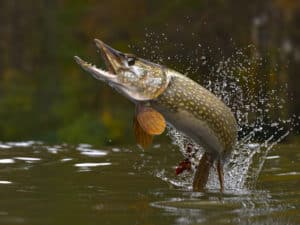Also simply known as the pike throughout much of Europe and North America, the northern pike is an impressive and highly sought-after catch amongst many anglers mainly due to its large size. Its heavy yet elongated body and large, bulky head with a long, pointed snout gives it a rather intimidating, almost serpentine or gator-like appearance. But how big do these fierce predators and prized game fish get when fully grown? Furthermore, what is the largest specimen ever caught? Read on to learn more.
Learn About the Northern Pike: Introduction and Fun Facts

The northern pike is easily recognizable thanks to its massive size, snake-like head, and torpedo-shaped body.
©iStock.com/abadonian
The northern pike’s common name is in part a reference to its geographic range, which is limited to the northern hemisphere, particularly northern Europe. The other half of its name comes from its overall resemblance to the pike, a long, spear-like weapon mainly used during the Middle Ages in Europe.
Additionally, the pike’s scientific name is Esox lucius. It is the type species for its genus, Esox. Esox consists of seven main species, including the closely-related muskellunge, American pickerel, and southern pike. Like the northern pike, all fish in the Esox genus (collectively simply known as the pikes) have long, torpedo-like bodies, pointed, snake-like heads, and sharp teeth. They’re also fearsome ambush predators that primarily feed on other, smaller fish.
Typically, the northern pike’s elongated yet hefty body is a dark, olive green in color, while its belly fades to a more yellowish or off-white hue. As juveniles, they have a more vibrant green coloration that is broken up by large, yellowish stripes. As pike age, their stripes break up into much smaller spots, while their overall body color becomes more dark and brownish.
The several large sensory pores along the sides of the pike’s head and jaw also become more prominent with age. These pores make up part of its lateral line system of sensory organs that help it navigate underwater.
Pike generally prefer clear, slow-moving freshwater habitats like streams and rivers as well as lakes and reservoirs with lots of plant cover. Juveniles are especially common in areas with more vegetation, as they need places to hide from their cannibalistic adult counterparts.
How Big Do Northern Pike Get?

Northern pike reach their full size in two to three years.
©bekirevren/Shutterstock.com
As the second-largest species in the pike family, the northern pike is impressive in length, weight, and size. It is only slightly smaller than the muskellunge on average, a species whose common name, when loosely translated from its Ojibwe roots, means “big, ugly pike.”
After developing for around two weeks in a tiny egg smaller than the size of your fingernail, northern pike fry hatch and get their nourishment from an egg sac attached to their bodies for the first 10 days or so of their lives. At this point, the fry are usually less than 10 millimeters long.
However, northern pike grow very quickly, reaching fingerling size after just a few weeks. At around one month old, they are already quite strong swimmers and have a strong set of sharp teeth to tear into small fish like minnows and aquatic insects. Though they’re only a few inches long at this stage, their bodies are already distinctly pike-like in appearance. However, juveniles must be wary of older, more mature pike, as they can be cannibalistic if their usual food sources are scarce.
By one year old, most northern pike are around one foot long and weigh close to half a pound. At this point, they begin growing especially rapidly. Within another year or two, they will reach their full size. Males are fully mature at around two years old, while females take a bit longer at roughly three years.
When fully grown, northern pike can range from 15 to 22 inches long on average. They usually weigh between 2 to 5 pounds, with females being larger than males. However, enormous individuals can grow to well over 15 pounds, with record specimens exceeding 30 pounds.
The Largest Northern Pike Ever Caught
According to the IGFA, the most giant all-tackle northern pike ever caught was a 55-pound specimen caught by angler Lothar Louis on Greffern Lake in Germany. Incredibly, Louis’ record has remained unbeaten since October 16, 1986.
It’s worth noting here that Eurasian northern pike tend to grow to slightly larger sizes on average than North American specimens. Germany’s Greffern Lake sits along the Rhine River in the small community of Greffern. Located in southwestern Germany, Greffern is part of the German state of Baden-Württemberg, which borders France and Switzerland.
Notably, Louis caught the world-record pike with a spoon lure. Spoon lures are typically metal and highly reflective, which helps to attract predatory fish like the northern pike. These small yet heavy lures also help to create turbulence in the water, which can further draw in pike.
Best Places and Time of Year to Catch Northern Pike

Northern pike are most common in clear, cool waters with plenty of plant cover to aid them in ambush hunting.
©Martin Prochazkacz/Shutterstock.com
As we touched on earlier, northern pike prefer fairly clear, cool waters with lots of nearby vegetation to cover them while ambush hunting. They’re also fairly hardy, though, and they can tolerate living in various habitats, from slow-moving rivers and streams to lakes and reservoirs. The presence of other fish species is a good sign, as pike primarily feed on other, smaller fish.
Though they can also reside in brackish waters temporarily, northern pike eventually return to freshwater after spending time in brackish habitats. Finally, spawning locations are important, with pike usually opting to lay their eggs in shallow areas with slow-moving currents and lots of plant cover.
The best time of year to catch northern pike is between spring and fall, ideally during the late morning to early afternoon hours. Late spring is preferable because pike become hungry after a typical spawning season. The summer-to-fall months can also be successful for anglers as pike remain very active during this time.
In terms of location, northern pike are especially abundant in the northern reaches of North America, primarily throughout the Upper Midwest, Canada, and Alaska.
What Do Northern Pike Eat?

These sneaky fish hide behind rocks and weeds and ambush their prey. Smart!
©Rostislav Stefanek/Shutterstock.com
Northern pike are apex predators and opportunistic feeders, meaning they will eat whatever is available. They primarily consume smaller fish such as minnows, perch, and sculpins but also feed on crayfish, frogs, aquatic insects, leeches, and small mammals. They also hunt by ambushing to take down their prey more easily. Northern pike have adapted over time to become better hunters, with some being able to launch themselves out of the water several inches to grab prey from above.
Northern pike have a large appetite, which helps them to grow quickly. They can consume up to 25% of their body weight in one day, so it’s important that they have plenty of food available. In the wild, this means having healthy and diverse aquatic ecosystems with plenty of prey species for them to hunt. If there is a lack of food or if the water has been overfished, northern pike may not reach their full potential size.
The photo featured at the top of this post is © iStock.com/abadonian
Thank you for reading! Have some feedback for us? Contact the AZ Animals editorial team.






